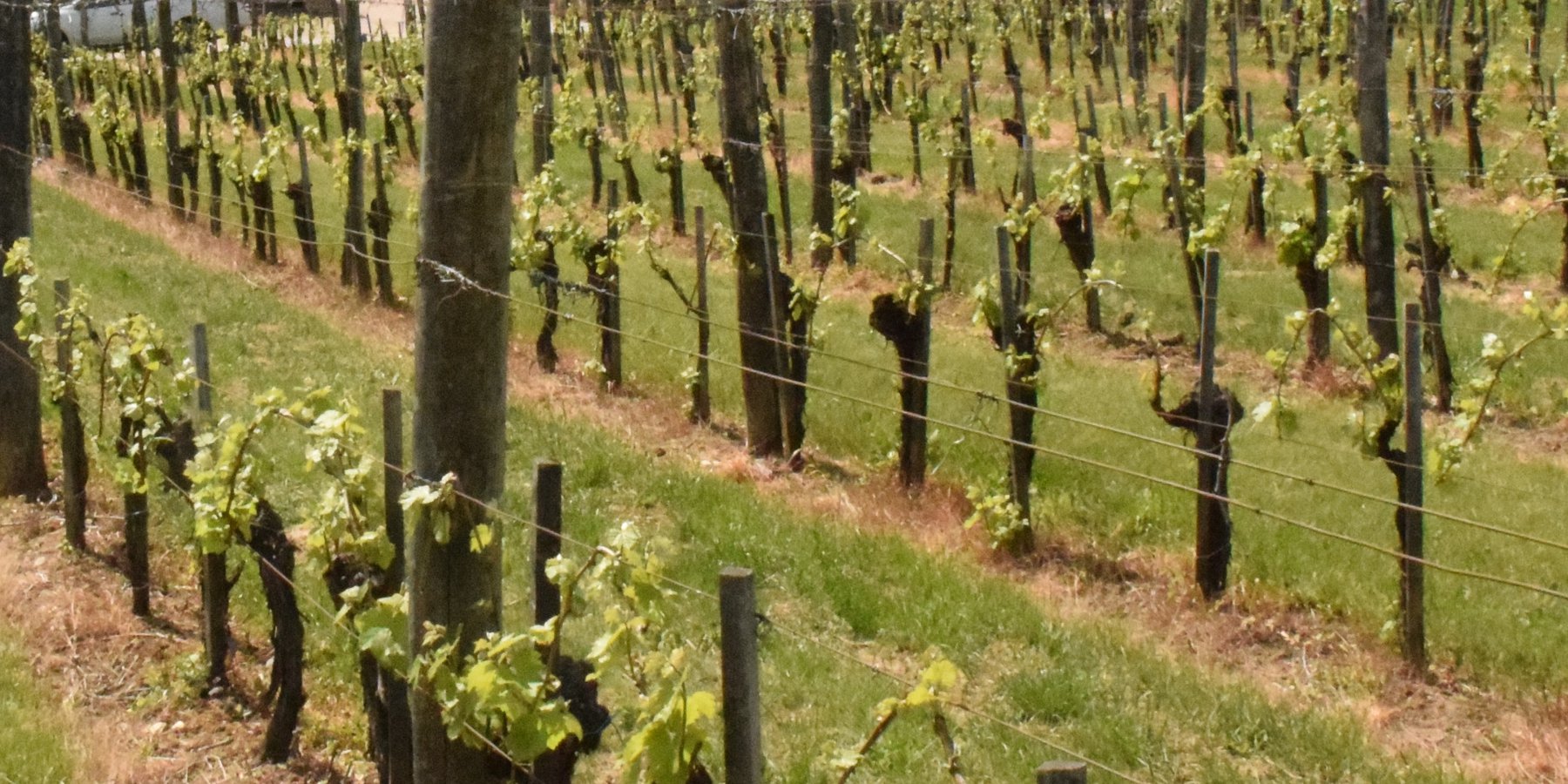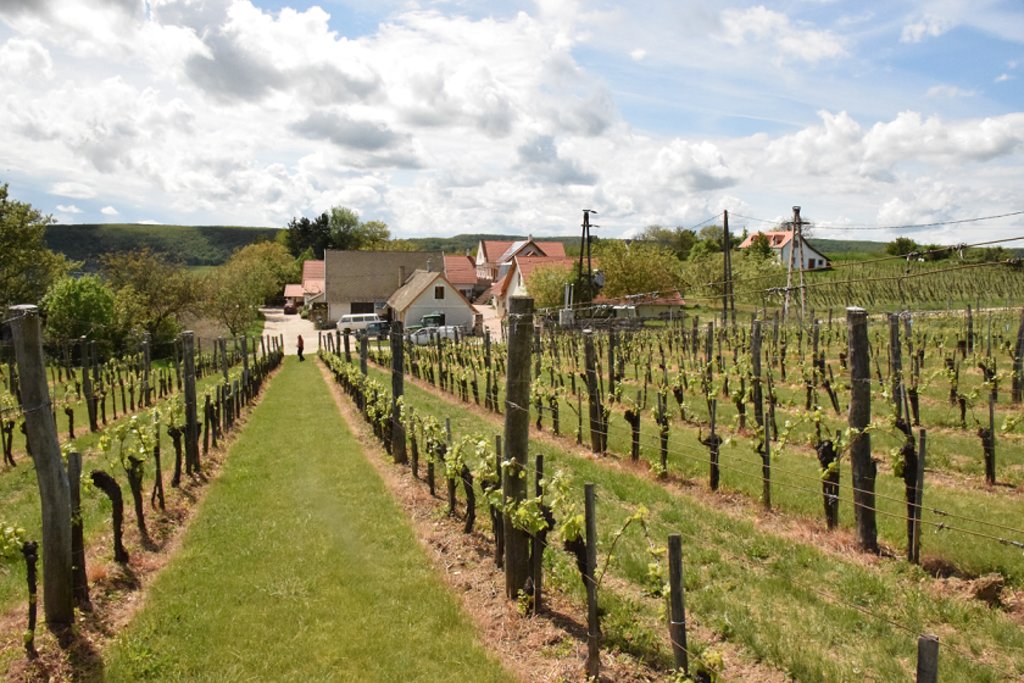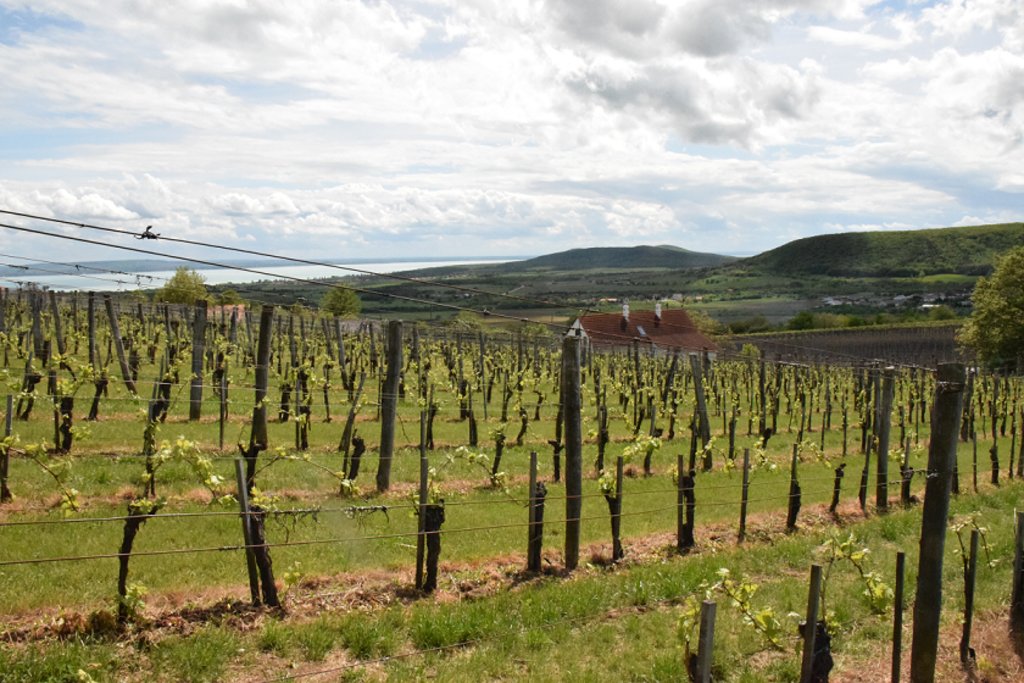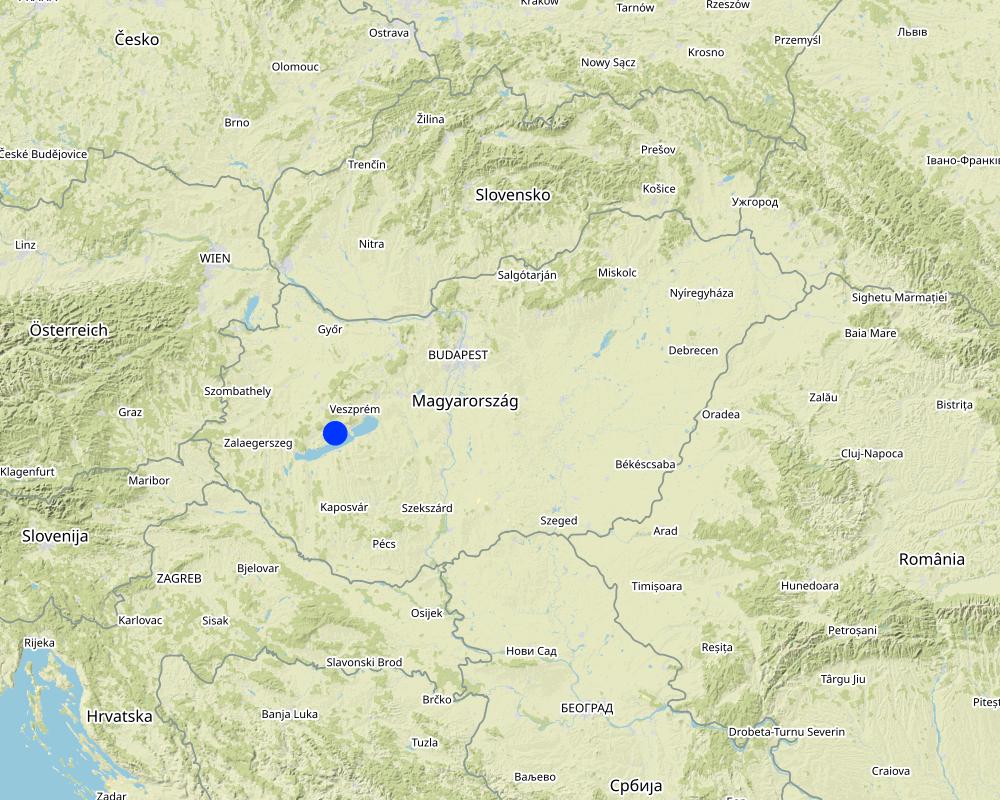Permanent grass cover in vineyards [Hungary]
- Creation:
- Update:
- Compiler: Brigitta Szabó
- Editors: Piroska Kassai, Zoltan Toth
- Reviewers: William Critchley, Rima Mekdaschi Studer
Sorközök füvesítése szőlőben
technologies_6194 - Hungary
View sections
Expand all Collapse all1. General information
1.2 Contact details of resource persons and institutions involved in the assessment and documentation of the Technology
Key resource person(s)
land user:
Hungary
Name of project which facilitated the documentation/ evaluation of the Technology (if relevant)
OPtimal strategies to retAIN and re-use water and nutrients in small agricultural catchments across different soil-climatic regions in Europe (OPTAIN)Name of the institution(s) which facilitated the documentation/ evaluation of the Technology (if relevant)
Institute for Soil Sciences, Centre for Agricultural Research (ATK TAKI) - Hungary1.3 Conditions regarding the use of data documented through WOCAT
The compiler and key resource person(s) accept the conditions regarding the use of data documented through WOCAT:
Yes
1.4 Declaration on sustainability of the described Technology
Is the Technology described here problematic with regard to land degradation, so that it cannot be declared a sustainable land management technology?
No
1.5 Reference to Questionnaire(s) on SLM Approaches (documented using WOCAT)
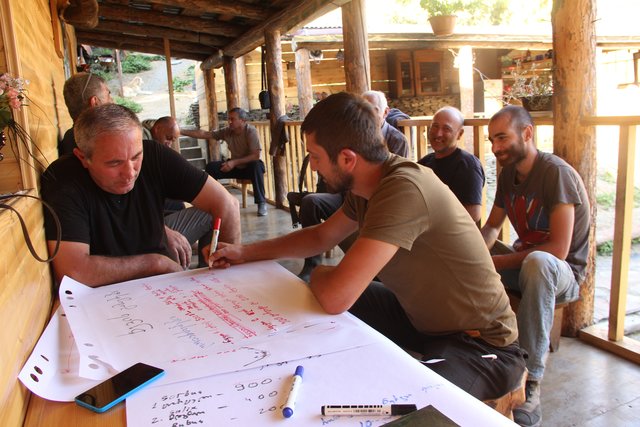
Integrated Pasture Management Planning in Mountainous Regions [Georgia]
The unsustainable use of pastures and forest areas has led to soil erosion, degradation, desertification and loss of biodiversity in the high mountain areas of the South Caucasus. The development of pasture passports is part of a broader approach to a strategic pasture management plan for Tusheti. This showcase includes …
- Compiler: Hanns Kirchmeir
2. Description of the SLM Technology
2.1 Short description of the Technology
Definition of the Technology:
Permanent grass cover under grape vines protects the soil surface against erosion and compaction - and provides better conditions for traffic within the rows during mechanised field operations
2.2 Detailed description of the Technology
Description:
Permanent grass cover under grape vines protects the soil surface against erosion and compaction - and provides better conditions for traffic within the rows during mechanised field operations. Grass can be sown using a mixture of grass and legume species - white clover, red clover, tall fescue are the most widely used - or it can be allowed to germinate naturally after stopping regular tillage applications. For the maintenance of grass cover and to avoid the disadvantages of tall grass it must be regularly cut. The height of the grass is most important directly below the grape rows. Grass clippings are a great source of nitrogen and break down quickly, so it can be used as mulch. But winegrowers/farmers who deal with animal husbandry too, prefer to use grass clippings as fodder. Herbicides are often used to control the grass in narrow strips underneath the grape rows.
One benefit of the grass cover is the good soil protection on slopes - where vineyards are often established due to better exposure to the sun. In addition, it gives better traction for machines, especially on steep gradients: this is appreciated by land users. Permanent grass cover makes for a cooler and more humid microclimate in the vineyard, but this means a greater risk of fungal diseases and loss of moisture due to the transpiration demand of the grass.
2.3 Photos of the Technology
2.4 Videos of the Technology
Comments, short description:
video is not available
2.5 Country/ region/ locations where the Technology has been applied and which are covered by this assessment
Country:
Hungary
Region/ State/ Province:
Veszprém County
Further specification of location:
Szentantalfa
Specify the spread of the Technology:
- applied at specific points/ concentrated on a small area
Is/are the technology site(s) located in a permanently protected area?
No
Map
×2.6 Date of implementation
If precise year is not known, indicate approximate date:
- 10-50 years ago
2.7 Introduction of the Technology
Specify how the Technology was introduced:
- through land users' innovation
3. Classification of the SLM Technology
3.1 Main purpose(s) of the Technology
- reduce, prevent, restore land degradation
- protect a watershed/ downstream areas – in combination with other Technologies
- preserve/ improve biodiversity
- reduce risk of disasters
- adapt to climate change/ extremes and its impacts
3.2 Current land use type(s) where the Technology is applied
Land use mixed within the same land unit:
No

Cropland
- Tree and shrub cropping
Tree and shrub cropping - Specify crops:
- grapes
3.3 Has land use changed due to the implementation of the Technology?
Has land use changed due to the implementation of the Technology?
- No (Continue with question 3.4)
3.4 Water supply
Water supply for the land on which the Technology is applied:
- rainfed
3.5 SLM group to which the Technology belongs
- improved ground/ vegetation cover
3.6 SLM measures comprising the Technology

vegetative measures
- V2: Grasses and perennial herbaceous plants
3.7 Main types of land degradation addressed by the Technology

soil erosion by water
- Wt: loss of topsoil/ surface erosion
- Wg: gully erosion/ gullying
3.8 Prevention, reduction, or restoration of land degradation
Specify the goal of the Technology with regard to land degradation:
- reduce land degradation
- adapt to land degradation
4. Technical specifications, implementation activities, inputs, and costs
4.1 Technical drawing of the Technology
Technical specifications (related to technical drawing):
The interrow space between grape lines are covered by permanent grass. Interrow space is 2-3 m.
Author:
Piroska Kassai
Date:
31/10/2022
4.2 General information regarding the calculation of inputs and costs
Specify how costs and inputs were calculated:
- per Technology area
Indicate size and area unit:
ha
Specify currency used for cost calculations:
- USD
Indicate average wage cost of hired labour per day:
50
4.3 Establishment activities
Comments:
Regular soil tillage is finished between the interrow space of vineyard. As a consequence permanent green cover will be developed. Grass cover will be dominant within a year.
4.4 Costs and inputs needed for establishment
Comments:
Permanent grass cover develops after the regular soil tillage is finished without any investment
4.5 Maintenance/ recurrent activities
| Activity | Timing/ frequency | |
|---|---|---|
| 1. | cutting grass | 4-5 times a year |
4.6 Costs and inputs needed for maintenance/ recurrent activities (per year)
| Specify input | Unit | Quantity | Costs per Unit | Total costs per input | % of costs borne by land users | |
|---|---|---|---|---|---|---|
| Other | 1st cutting grass is carried out by a contractor | ha | 1.0 | 35.0 | 35.0 | 100.0 |
| Other | 2nd cutting grass is carried out by a contractor | ha | 1.0 | 35.0 | 35.0 | 100.0 |
| Other | 3rd cutting grass is carried out by a contractor | ha | 1.0 | 35.0 | 35.0 | 100.0 |
| Other | 4th cutting grass is carried out by a contractor | ha | 1.0 | 35.0 | 35.0 | 100.0 |
| Other | 5th cutting grass is carried out by a contractor | ha | 1.0 | 35.0 | 35.0 | 100.0 |
| Total costs for maintenance of the Technology | 175.0 | |||||
| Total costs for maintenance of the Technology in USD | 175.0 | |||||
4.7 Most important factors affecting the costs
Describe the most determinate factors affecting the costs:
fuel prices
5. Natural and human environment
5.1 Climate
Annual rainfall
- < 250 mm
- 251-500 mm
- 501-750 mm
- 751-1,000 mm
- 1,001-1,500 mm
- 1,501-2,000 mm
- 2,001-3,000 mm
- 3,001-4,000 mm
- > 4,000 mm
Specify average annual rainfall (if known), in mm:
600.00
Agro-climatic zone
- sub-humid
5.2 Topography
Slopes on average:
- flat (0-2%)
- gentle (3-5%)
- moderate (6-10%)
- rolling (11-15%)
- hilly (16-30%)
- steep (31-60%)
- very steep (>60%)
Landforms:
- plateau/plains
- ridges
- mountain slopes
- hill slopes
- footslopes
- valley floors
Altitudinal zone:
- 0-100 m a.s.l.
- 101-500 m a.s.l.
- 501-1,000 m a.s.l.
- 1,001-1,500 m a.s.l.
- 1,501-2,000 m a.s.l.
- 2,001-2,500 m a.s.l.
- 2,501-3,000 m a.s.l.
- 3,001-4,000 m a.s.l.
- > 4,000 m a.s.l.
Indicate if the Technology is specifically applied in:
- not relevant
5.3 Soils
Soil depth on average:
- very shallow (0-20 cm)
- shallow (21-50 cm)
- moderately deep (51-80 cm)
- deep (81-120 cm)
- very deep (> 120 cm)
Soil texture (topsoil):
- medium (loamy, silty)
Soil texture (> 20 cm below surface):
- medium (loamy, silty)
Topsoil organic matter:
- medium (1-3%)
5.4 Water availability and quality
Ground water table:
5-50 m
Availability of surface water:
good
Water quality (untreated):
poor drinking water (treatment required)
Water quality refers to:
surface water
Is water salinity a problem?
No
Is flooding of the area occurring?
No
5.5 Biodiversity
Species diversity:
- medium
Habitat diversity:
- high
5.6 Characteristics of land users applying the Technology
Sedentary or nomadic:
- Sedentary
Market orientation of production system:
- mixed (subsistence/ commercial)
Off-farm income:
- 10-50% of all income
Relative level of wealth:
- average
Individuals or groups:
- individual/ household
Level of mechanization:
- mechanized/ motorized
Gender:
- women
- men
Age of land users:
- middle-aged
5.7 Average area of land used by land users applying the Technology
- < 0.5 ha
- 0.5-1 ha
- 1-2 ha
- 2-5 ha
- 5-15 ha
- 15-50 ha
- 50-100 ha
- 100-500 ha
- 500-1,000 ha
- 1,000-10,000 ha
- > 10,000 ha
Is this considered small-, medium- or large-scale (referring to local context)?
- medium-scale
5.8 Land ownership, land use rights, and water use rights
Land ownership:
- individual, not titled
Land use rights:
- individual
Water use rights:
- communal (organized)
Are land use rights based on a traditional legal system?
Yes
5.9 Access to services and infrastructure
health:
- poor
- moderate
- good
education:
- poor
- moderate
- good
technical assistance:
- poor
- moderate
- good
employment (e.g. off-farm):
- poor
- moderate
- good
markets:
- poor
- moderate
- good
energy:
- poor
- moderate
- good
roads and transport:
- poor
- moderate
- good
drinking water and sanitation:
- poor
- moderate
- good
financial services:
- poor
- moderate
- good
6. Impacts and concluding statements
6.1 On-site impacts the Technology has shown
Ecological impacts
Water cycle/ runoff
surface runoff
Comments/ specify:
Surface runoff decreases because infiltration improves significantly in vineyards with grass cover crops
excess water drainage
Soil
soil loss
Comments/ specify:
Grass cover crops in vineyards can reduce soil erosion rates by four- to six-times compared to tillage.
Biodiversity: vegetation, animals
Vegetation cover
plant diversity
Climate and disaster risk reduction
micro-climate
Comments/ specify:
Humidity of microclimate is increased, resulting in higher risk of diseases
6.2 Off-site impacts the Technology has shown
downstream flooding
downstream siltation
damage on public/ private infrastructure
6.3 Exposure and sensitivity of the Technology to gradual climate change and climate-related extremes/ disasters (as perceived by land users)
Gradual climate change
Gradual climate change
| Season | increase or decrease | How does the Technology cope with it? | |
|---|---|---|---|
| annual temperature | increase | well | |
| seasonal rainfall | summer | decrease | well |
Climate-related extremes (disasters)
Meteorological disasters
| How does the Technology cope with it? | |
|---|---|
| local rainstorm | well |
Climatological disasters
| How does the Technology cope with it? | |
|---|---|
| heatwave | moderately |
Biological disasters
| How does the Technology cope with it? | |
|---|---|
| epidemic diseases | not well at all |
6.4 Cost-benefit analysis
How do the benefits compare with the establishment costs (from land users’ perspective)?
Short-term returns:
neutral/ balanced
Long-term returns:
neutral/ balanced
How do the benefits compare with the maintenance/ recurrent costs (from land users' perspective)?
Short-term returns:
neutral/ balanced
Long-term returns:
neutral/ balanced
6.5 Adoption of the Technology
- 11-50%
Of all those who have adopted the Technology, how many did so spontaneously, i.e. without receiving any material incentives/ payments?
- 91-100%
6.6 Adaptation
Has the Technology been modified recently to adapt to changing conditions?
Yes
If yes, indicate to which changing conditions it was adapted:
- climatic change/ extremes
Specify adaptation of the Technology (design, material/ species, etc.):
Using drought-tolerant grass species
6.7 Strengths/ advantages/ opportunities of the Technology
| Strengths/ advantages/ opportunities in the land user’s view |
|---|
| good soil conservation - increases soil organic carbon and improves aggregate stability |
| reduces soil loss |
| Strengths/ advantages/ opportunities in the compiler’s or other key resource person’s view |
|---|
| Less nutrient load through erosion (off-site effect) |
6.8 Weaknesses/ disadvantages/ risks of the Technology and ways of overcoming them
| Weaknesses/ disadvantages/ risks in the land user’s view | How can they be overcome? |
|---|---|
| cutting grass is regulary needed |
| Weaknesses/ disadvantages/ risks in the compiler’s or other key resource person’s view | How can they be overcome? |
|---|---|
| vineyard microclimate is more humid, resulting in higher risk of diseases |
7. References and links
7.1 Methods/ sources of information
- field visits, field surveys
5
- interviews with land users
5
When were the data compiled (in the field)?
14/06/2022
7.2 References to available publications
Title, author, year, ISBN:
Cover cropping in vineyards - A grower's handbook, Published by Agriculture & Natural Resources 2002-01-01, 2002, ISBN 10: 187990635X / ISBN 13: 9781879906358
Available from where? Costs?
From LowKeyBooks (Sumas, WA, U.S.A.)
7.3 Links to relevant online information
Title/ description:
Overview of Vineyard Floor Management
URL:
https://grapes.extension.org/overview-of-vineyard-floor-management/
7.4 General comments
filling out the questionnaire is time consuming
Links and modules
Expand all Collapse allLinks

Integrated Pasture Management Planning in Mountainous Regions [Georgia]
The unsustainable use of pastures and forest areas has led to soil erosion, degradation, desertification and loss of biodiversity in the high mountain areas of the South Caucasus. The development of pasture passports is part of a broader approach to a strategic pasture management plan for Tusheti. This showcase includes …
- Compiler: Hanns Kirchmeir
Modules
No modules


